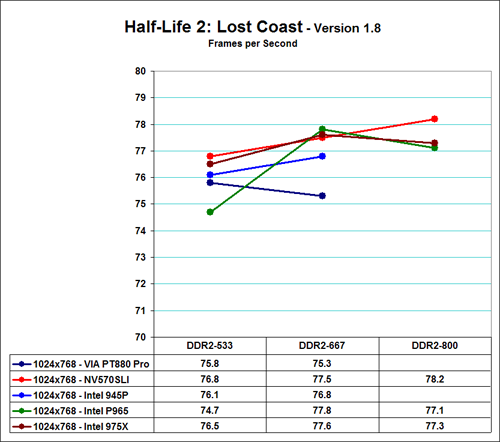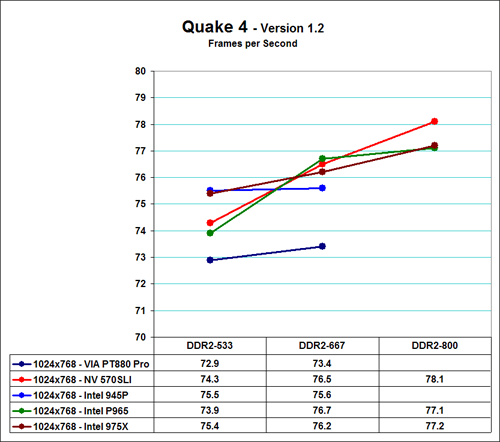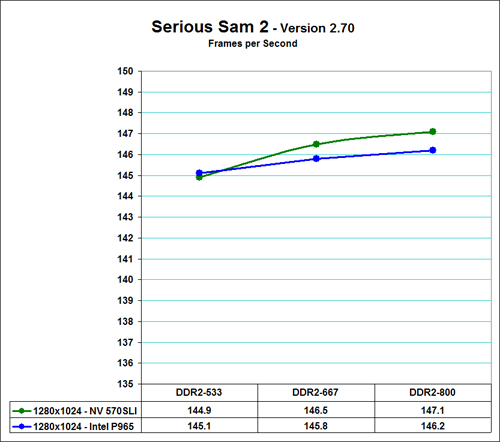ASUS P5NSLI: Core 2 Duo and SLI on a Budget
by Gary Key on August 22, 2006 5:30 AM EST- Posted in
- Motherboards
Gaming Performance - E6300/7600GS
While Sandra and Super Pi provide useful information on how memory performs without the influence of other components, our first round of real world tests has shown there is not a noticeable difference in performance between DDR2-533 and DDR2-800 except with the NVIDIA 570SLI chipset. However, our next set of real-world benchmarks consists of gaming benchmarks. Due to the amount of information and the relative closeness of the scores we are not utilizing zero based charts as the line graphs would stack on each other. Although the data chart tells the story we felt like there should be some separation in the line graphs to accurately depict the information. Zero-based graphs are available by clicking on the charts below if you would like to see the bigger picture.
We are utilizing Half Life 2 and Quake 4 in our testing because they are sensitive to memory bandwidth changes. We added Serious Sam 2 to our benchmark mix because it is typically very GPU dependent and we will see the effects of our memory/GPU choices on these games. We tested at both 1024x768 (E6300) and 1280x1024 (E6700) resolutions at High Quality settings with 4x anti-aliasing and 8x antistrophic filtering enabled at 1280x1024.
Our two memory sensitive games show a pattern with the ASUS P5NSLI motherboard performing extremely well at all memory settings with a constant scaling in performance even in the GPU limited Serious Sam 2. The 570SLI results in gaming are almost opposite of our synthetic and application benchmarks. It appears the old adage that NVIDIA hardware runs best on NVIDIA hardware is true in this case. This is a very small sampling of games at this time and the GPU choice does not match what most buyers of this board would run. However, we find this result interesting from a viewpoint that memory bandwidth is extremely important for the 570SLI to operate at an optimum level.
Gaming Performance - E6700/7950GX2
We see the performance of the Intel P965 leading the NVIDIA 570SLI in our memory sensitive games once we introduce our E6700 processor and 7950GX2 video card. These results are more in alignment with the synthetic benchmark results where the P965 had the highest Unbuffered memory scores along with the lowest latencies overall. While the 570SLI scales well, the P965 chipset's superior bandwidth just outperforms the 570SLI in this situation. The result in Serious Sam 2 shows the 570SLI performing better in a GPU limited situation where NVIDIA typically shines. Once again we see the 570SLI scaling well as we improve bandwidth.
While Sandra and Super Pi provide useful information on how memory performs without the influence of other components, our first round of real world tests has shown there is not a noticeable difference in performance between DDR2-533 and DDR2-800 except with the NVIDIA 570SLI chipset. However, our next set of real-world benchmarks consists of gaming benchmarks. Due to the amount of information and the relative closeness of the scores we are not utilizing zero based charts as the line graphs would stack on each other. Although the data chart tells the story we felt like there should be some separation in the line graphs to accurately depict the information. Zero-based graphs are available by clicking on the charts below if you would like to see the bigger picture.
We are utilizing Half Life 2 and Quake 4 in our testing because they are sensitive to memory bandwidth changes. We added Serious Sam 2 to our benchmark mix because it is typically very GPU dependent and we will see the effects of our memory/GPU choices on these games. We tested at both 1024x768 (E6300) and 1280x1024 (E6700) resolutions at High Quality settings with 4x anti-aliasing and 8x antistrophic filtering enabled at 1280x1024.
 |
 |
 |
| Click for Zero-based Graph |
Our two memory sensitive games show a pattern with the ASUS P5NSLI motherboard performing extremely well at all memory settings with a constant scaling in performance even in the GPU limited Serious Sam 2. The 570SLI results in gaming are almost opposite of our synthetic and application benchmarks. It appears the old adage that NVIDIA hardware runs best on NVIDIA hardware is true in this case. This is a very small sampling of games at this time and the GPU choice does not match what most buyers of this board would run. However, we find this result interesting from a viewpoint that memory bandwidth is extremely important for the 570SLI to operate at an optimum level.
Gaming Performance - E6700/7950GX2
 |
 |
 |
| Click for Zero-based Graph |
We see the performance of the Intel P965 leading the NVIDIA 570SLI in our memory sensitive games once we introduce our E6700 processor and 7950GX2 video card. These results are more in alignment with the synthetic benchmark results where the P965 had the highest Unbuffered memory scores along with the lowest latencies overall. While the 570SLI scales well, the P965 chipset's superior bandwidth just outperforms the 570SLI in this situation. The result in Serious Sam 2 shows the 570SLI performing better in a GPU limited situation where NVIDIA typically shines. Once again we see the 570SLI scaling well as we improve bandwidth.










27 Comments
View All Comments
Calin - Tuesday, August 22, 2006 - link
I wonder if the FSB wall (the 320-321 MHz) the mainboard run into is real or an engineering trick... Conspiracy theory, but I think that the top-end chipset might reach a much higher FSB, luring overclockers to pay a handfull of dollars for the premium chipsetGary Key - Tuesday, August 22, 2006 - link
On the previous C19A boards we hit 268FSB with a Pentium 4. We were starting at a 200FSB level. We are now starting at a 266FSB and hitting around the 320FSB level which is actually lower from the base. The Intel NVIDIA chipsets have never been good overclockers and our sample will not even post past 325FSB. We are expecting our final NF590SLI sample this week so it will be interesting if there is a cap although I doubt it.
shabby - Tuesday, August 22, 2006 - link
321 max fsb? Who in their right mind would buy this mobo when the gigabyte ds3 hits speeds over 500fsb?bob661 - Tuesday, August 22, 2006 - link
Because this board costs $120 or lower and has more features (SLI). Not everyone OC's their motherboard. Besides, the DS3 has questionable stability. Why would I or other non-OCers would want to pay $140+ for a board (DS3) that has less features and less stability? Also, DS3's are NOT hitting 500 fsb regularly. A fortunate few are getting 500 fsb but not everyone.DigitalDivine - Tuesday, August 22, 2006 - link
i thought asus would have phased out their signiture gold puke color by now. that board is probably the ugliest i've seen come out of asus, it's not subtle, but bright!!!! black is a very nice color... stick with black... or go platinum silver (i miss my soyo dragon)...the sad part in all of this is that their low cost subsidiary "asrock" offers a very tasteful blue color for their boards.
---------------------------------
This board will be excellent for when i buy a conroe though, maybe i'll wait to see what other manufacturers will be able to put out.
R3MF - Tuesday, August 22, 2006 - link
why does the Intel version of the 570SLI have only 20 PCIe lanes when the AMD version of the 570SLI has 28 PCIe lanes?Gary Key - Tuesday, August 22, 2006 - link
They are not utilizing the same chipset. The 570SLI for Intel Edition is just updated marketing language for the existing C19A+/MCP51(nForce 430).